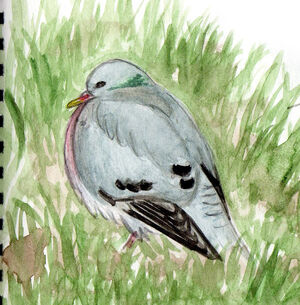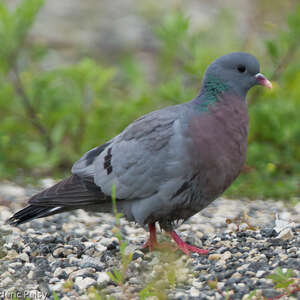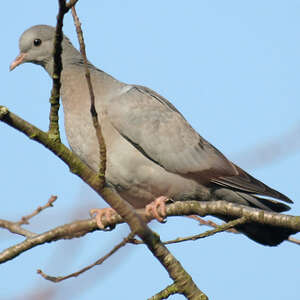Stock Dove
Columba oenas - Pigeon colombin
Identification
The Stock Dove is the smallest of the three European pigeons. It is also the least conspicuous, the least apparent. The sexes are also similar in this bird. It is recognized, in addition to its size, by the uniformity of its plumage. Indeed, its upper parts are light blue-gray only marked by a small black wing bar on the large coverts and a little black on the tertiary remiges, which can not be seen in flight. In flight, from above, one sees a small two-tone gray and black pigeon, light gray on the body, the wing coverts, the base of the primaries and the base of the tail, black on the tip of the primaries, the outer secondaries and the tip of the tail. The resulting contrast is typical. Note the absence of white that characterizes the other two species. The chest and front of the neck are a vinous gray forming a plastron. In flight, from below, one has the same contrast as above, but attenuated. The head is gray. The iris is dark brown and the eye surrounded by a gray circle barely visible. The beak, pink with yellow tip, has a white wax at the base. The sides of the neck show a wide iridescent green reflecting area. The legs are a deep pink.
The juvenile is more dull, more uniform. It has no colored reflections on the neck or plastron on the chest. Beak and legs are paler.
Subspecific information 2 subspecies
- Columba oenas oenas (w Europe and nw Africa to n Kazakhstan, sw Siberia and n Iran)
- Columba oenas yarkandensis (se Kazakhstan and Uzbekistan to w China)
Foreign names
- Pigeon colombin,
- Paloma zurita,
- seixa-europeia,
- Hohltaube,
- kék galamb,
- Holenduif,
- Colombella,
- skogsduva,
- Skogdue,
- holub plúžik,
- holub doupňák,
- Huldue,
- uuttukyyhky,
- xixella,
- Holudúfa,
- siniak,
- meža balodis,
- duplar,
- Клинтух,
- ヒメモリバト,
- 欧鸽,
- skogsduva,
- 歐鴿,
Voice song and call
The males sing a loud but muffled single note that is repeated, sounding like "wou oup wou oup wou oup.... It can sound like a single note when the second part is swallowed. Like the wood pigeon, the frequency of the notes makes it possible for the song to penetrate the thick forest foliage. During the prenuptial parade, they emit a rapid series of 8-10 weak cuckoo notes, coucou cou cou:
Habitat
The Stock Dove is a bird of the woods originally. It still remains so mostly. As it is cavernicolous for nesting purposes, the habitat must provide the cavities it needs.
The Stock Dove has another fundamental requirement. It feeds on the ground in open spaces and must therefore have open spaces nearby its nesting sites, usually agricultural land, where it can search for its food. These two conditions mean that the Stock Dove is primarily a bird of the plains where these requirements are more easily met. Nevertheless, in the southern part of its range, for example in Morocco, it climbs up to more than 2000m to find the favourable conditions. It has such flying power that even the large forest areas can be occupied.
The Stock Dove can be rocky for nesting and nest in natural or artificial cliffs but is rarely seen. It is more commonly found in urban or sub-urban contexts (old parks, alleys of old trees).
In the inter-season, it is somewhat the opposite. It feeds in open spaces in flocks, usually agricultural areas, and spends the night in nearby trees, probably with the company of wood pigeons.
Behaviour character trait
The Stock Dove exhibits the same characteristics of habitat diversity as the more Common Wood Pigeon.
It is remarkable to witness how such birds can inhabit remote, wooded parts of the country far away from human activities, as well as parks in urban areas which are heavily anthropized.During the breeding season, the Stock Dove is a monogamous and territorial species. The male will display by flying slowly with wide beats, and snapping the tips of its wings over its back. Then he will glide from tree to tree, tail extended and wings raised, around the hollow tree.
Like many other birds, it becomes gregarious after breeding. It can even mix with other species when foraging. The north-eastern birds will group together from September to October for migration. They can be seen passing in small groups at a swift pace at the migration tracking points. It is also typical to observe some of them migrating within flocks of Wood Pigeons. They can be identified by their small size.
Flight
Dietfeeding habits
The Stock Dove feeds on the ground in open, natural or agricultural environments. It is mostly vegetarian but can also swallow some invertebrates.
Depending on the season, it eats grains, fallen or in place, flower buds, young green shoots, etc. Like many other birds, it seeks out lost harvest parts. It goes to the water to drink.The young Stock Doves in the nest are fed for about 2 weeks by a liquid produced by the walls of the gular pouch of both adults, called pigeon milk and expelled from throat to throat.
Reproduction nesting
The breeding season starts in April in the south of its range, and later in May-June in more northern latitudes.
In the first case, two successful clutches are possible, not in the latter. The Stock Dove is the only columbiform to almost exclusively nest in cavities, whether they be natural or a nest box. Once the suitable cavity is located or the previous one is rediscovered after a few months of absence, the pair begins courtship (see above). The actual nesting depends on the nature and condition of the cavity. The cavity can be in a tree (most common case), in a rock or cliff face, and finally in a building, which all amount to rock nesting. An artificial nest box can be adopted. It can happen that the female can lay eggs without any improvements, directly on the substratum of the cavity's bottom. This is especially true with black woodpecker burrows in beech trees, often adopted as they are well suited to the dove's size. Otherwise, the pair collects twigs to serve as a bed for the eggs.The female lays two eggs, as is the rule for columbids, who will be incubated for 16-18 days. The young are able to fly at the age of one month. The female can then begin the, if necessary, second reproduction.
A nesting can fail due to the Pine Marten, a forest mustelid which also visits cavities in trees for rest. It is evident that if a marten falls upon a Stock Dove's nest, the clutch or nestling is lost.
Geographic range
The Stock Dove has a mainly European range at boreal, temperate and Mediterranean latitudes. Its range spills over into Morocco to the west, Anatolia and northern Iran to the east, where it becomes a mountain species. The European range also stretches eastwards to the centre of the Eur-Asian continent in southern Russia and northern Kazakhstan. Lastly, an isolated mountain breed of a distinct subspecies, the ssp. yarkandensis, occupies an area ranging from eastern Uzbekistan to western China.
Birds from boreal regions and those inside continental range subject to continental climate are migratory. They move southwards towards the range and join sedentary southern birds with which they winter.
Threats - protection
IUCN conservation status
concern
in the Wild
threatened
evaluated
The Stock Dove is classed as Least Concern by BirdLife International. Therefore, the species is not threatened. Its numbers are still numerous and the European populations are generally increasing. However, it is also known that the Stock Dove was much more common in the past than nowadays and experienced a dramatic decline in its population. It is likely that the initial level will never be recovered due to environmental changes.
Sources of information
- IOC World Bird List (v15.1), Gill, F and D Donsker (Eds). 2025-12-07.
- Limicoles, gangas et pigeons d'Europe, Paul Géroudet (mise à jour Georges Olioso)
- Pigeons and Doves, A Guide to the Pigeons and Doves of the World, GIBBS David
- Avibase, Lepage Denis
- Birds of the World, The Cornell Lab of Ornithology
- xeno-canto, Sharing bird sounds from around the world,
Other sources of interest
 Specification sheet created on
24/07/2023 by Jean François
Specification sheet created on
24/07/2023 by Jean FrançoisTranslation by AI Oiseaux.net
© 1996-2026 Oiseaux.net
- Accipitriformes
- Aegotheliformes
- Anseriformes
- Apodiformes
- Apterygiformes
- Bucerotiformes
- Caprimulgiformes
- Cariamiformes
- Casuariiformes
- Charadriiformes
- Ciconiiformes
- Coliiformes
- Columbiformes
- Coraciiformes
- Cuculiformes
- Eurypygiformes
- Falconiformes
- Galliformes
- Gaviiformes
- Gruiformes
- Leptosomiformes
- Mesitornithiformes
- Musophagiformes
- Nyctibiiformes
- Opisthocomiformes
- Otidiformes
- Passeriformes
- Pelecaniformes
- Phaethontiformes
- Phoenicopteriformes
- Piciformes
- Podargiformes
- Podicipediformes
- Procellariiformes
- Psittaciformes
- Pterocliformes
- Rheiformes
- Sphenisciformes
- Steatornithiformes
- Strigiformes
- Struthioniformes
- Suliformes
- Tinamiformes
- Trogoniformes


































